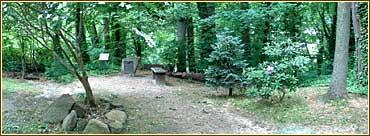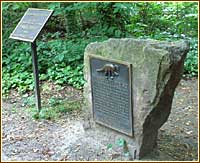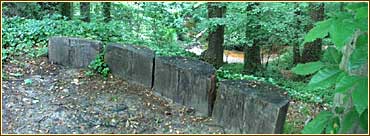

|

...
Haddonfield's Dinosaur Discovery Park
|

|
|
The Haddonfield dinosaur discovery site is located in a wooded area at the end of Maple Avenue in Haddonfield and includes historic markers, a bench and an overlook above a deep ravine. Take a VIDEO TOUR of the discovery site.
|
|
|
HADDONFIELD, N.J. -- Traversed by a stream in a deep ravine, the site of the 1858 Hadrosaurus foulkii discovery sits at the edge of a narrow corridor of Camden County Park land that forms the border between Haddonfield and Cherry Hill.
Since it was officially marked by Eagle Scout Christopher Brees in 1984,

|
|
Two historical markers stand in Hadrosaurus Park. A stone-mounted memorial created and placed by Christopher Brees in 1984 was the first. A second, pole-mounted plaque was erected in 1994 when the Hadrosaurus foulkii discovery site was declared a national historic landmark.
|
|
the site has been maintained as a public mini-park. Brees's father, Butch Brees, a member of the Haddonfield Dinosaur Sculpture Committee, serves as curator of the Hadrosaurus Park.
Although it is hidden away at the end of a quiet surburban street and not well marked on connecting roads, the site just off Maple Avenue and Grove Street gets at least 100 visitors a month, including a significant number from other countries such as Japan and Germany.
Some visitors are serious paleontology buffs or university students who want to stand at the place where the world's first nearly-complete dinosaur skeleton was excavated. A visit to the actual excavation site at the bottom of the ravine turns out to be no easy task -- the ravine below the mini-park is in its wild state with only crude footpaths through thick underbrush and a good deal of unavoidable shoreline mud.
Haddonfield, Cherry Hill and the Camden Country Board of Freeholders are currently in discussions to establish a walkway and other features that would make the historic location safer and more enjoyable to visit.
| |

|
|
Directly behind the plaques and bench area of Hadrosaurus Park, the ground drops away into a ravine where the clay-colored water of Hadrosaurus Run can be seen. A short distance downstream is the actual excavation site where the dinosaur bones were found in 1858.
|
|
Photos, this page: Hoag Levins
All Rights Reserved © 2002 - 2008, Hadrosaurus.com
Editor, Hadrosaurus.com
.
|

|







